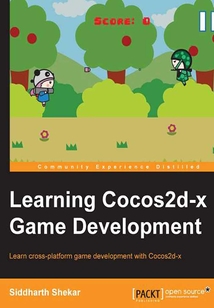目錄(100章)
倒序
- 封面
- 版權(quán)頁(yè)
- Credits
- About the Author
- Acknowledgments
- About the Reviewers
- www.PacktPub.com
- Support files eBooks discount offers and more
- Preface
- What this book covers
- What you need for this book
- Who this book is for
- Conventions
- Reader feedback
- Customer support
- Chapter 1. Getting Started
- Downloading and installing Visual Studio
- Downloading and installing the Windows Phone SDK
- Downloading and installing Python
- Downloading Cocos2d-x
- Creating a new project
- Coordinate system
- Basic classes of Cocos2d-x
- Project breakup
- Running the project on multiple platforms
- Summary
- Chapter 2. Displaying the Hero and Controls
- First things first
- Displaying the background image
- Character movement
- Enabling the touch function
- Enabling multitouch
- Movement with touches
- Movement with the accelerometer
- Custom controls
- Summary
- Chapter 3. Enemies and Controls
- Creating the enemy class
- Adding the gameplay layer
- Creating the projectile class
- Adding hero controls
- Summary
- Chapter 4. Collision Detection and Scoring
- Theory of collision detection
- Coding collision detection
- Keeping track of the score and the game over condition
- Storing high scores
- Summary
- Chapter 5. HUD Parallax Background and the Pause Button
- Texts and fonts
- Creating the HUD layer and displaying as well as updating scores
- Creating the pause button and showing the pause screen
- Implementing pause and resuming the game
- Adding the scrolling layer class
- Creating the parallax scrolling layer
- Summary
- Chapter 6. Animations
- Animation basics
- TexturePacker
- Creating a spritesheet for the player
- Coding the player animation
- Creating and coding enemy animation
- Creating the skeletal animation
- Coding the player walk cycle
- Summary
- Chapter 7. Particle Systems
- What is a particle system?
- Cocos2d-x's inbuilt particle system
- Adding the gun muzzle particle system
- Adding an explosion particle system
- Adding particles for jetpack when a player moves upwards
- Creating your own particle system
- Summary
- Chapter 8. Adding Main and Option Menu Scenes
- Creating the main menu scene
- Loading the menu scene at start of the app
- Creating the Options scene
- Changing the name of the app
- Summary
- Chapter 9. Adding Sounds and Effects
- Audio in Cocos2d-x
- Adding looped background music
- Adding sound effects
- Adding the mute button
- Summary
- Chapter 10. Publishing to the Windows Phone Store
- A look at the Windows Phone Store
- Creating the store account
- Preparing/creating the app
- Creating the app and setting pricing
- Uploading the XAP file icons and screenshots for review
- Summary
- Chapter 11. Porting References and Final Remarks
- Running the game on the Windows desktop
- Running the game on the Android simulator using the Eclipse IDE
- Running on the BlackBerry simulator using the Momentics IDE
- Running on an iOS simulator using Xcode
- Additional learning resources
- Final remarks and a thank you note
- Index 更新時(shí)間:2021-08-05 18:00:40
推薦閱讀
- 網(wǎng)絡(luò)服務(wù)器配置與管理(第3版)
- 電腦維護(hù)與故障排除傻瓜書(Windows 10適用)
- Effective STL中文版:50條有效使用STL的經(jīng)驗(yàn)(雙色)
- 電腦組裝、維護(hù)、維修全能一本通(全彩版)
- 平衡掌控者:游戲數(shù)值經(jīng)濟(jì)設(shè)計(jì)
- AMD FPGA設(shè)計(jì)優(yōu)化寶典:面向Vivado/SystemVerilog
- Hands-On Machine Learning with C#
- Arduino BLINK Blueprints
- Machine Learning with Go Quick Start Guide
- Building 3D Models with modo 701
- 基于Proteus仿真的51單片機(jī)應(yīng)用
- 微型計(jì)算機(jī)系統(tǒng)原理及應(yīng)用:國(guó)產(chǎn)龍芯處理器的軟件和硬件集成(基礎(chǔ)篇)
- 單片機(jī)原理與技能訓(xùn)練
- Spring Security 3.x Cookbook
- Deep Learning with Keras
- Learning Less.js
- FPGA進(jìn)階開發(fā)與實(shí)踐
- Practical Artificial Intelligence and Blockchain
- Mastering Unity 2D Game Development
- Hands-On Embedded Programming with C++17
- 51單片機(jī)新穎實(shí)例非常入門與視頻演練
- Mastering TensorFlow 1.x
- 21天學(xué)通筆記本電腦維修
- Nginx應(yīng)用與運(yùn)維實(shí)戰(zhàn)
- Photographic Rendering with VRay for SketchUp
- Managing Multimedia and Unstructured Data in the Oracle Database
- Linux虛擬化數(shù)據(jù)中心實(shí)戰(zhàn)
- CXL體系結(jié)構(gòu):高速互連的原理解析與實(shí)踐
- 筆記本電腦維修寶典
- 范例學(xué)電腦系統(tǒng)安裝與維護(hù)


